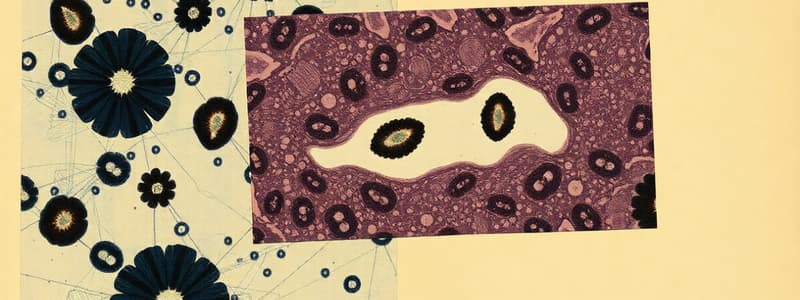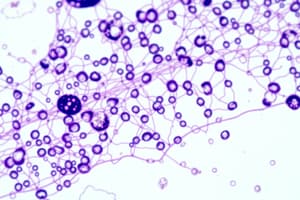Podcast
Questions and Answers
Which dye stains nuclei blue by binding to negatively charged structures?
Which dye stains nuclei blue by binding to negatively charged structures?
- Haematoxylin (correct)
- Oil Red O
- Alcian Blue
- Eosin
What color does the cytoplasm stain when using Eosin?
What color does the cytoplasm stain when using Eosin?
- Black
- Blue
- Pink (correct)
- Green
Which of the following dyes is used to stain fat in unfixed frozen sections?
Which of the following dyes is used to stain fat in unfixed frozen sections?
- DAPI
- Masson’s Trichrome
- Oil Red O (correct)
- Haematoxylin
What is the color of collagen when stained with Millers Sirius Red?
What is the color of collagen when stained with Millers Sirius Red?
Alcian Blue is primarily used to stain which type of cellular structure?
Alcian Blue is primarily used to stain which type of cellular structure?
Which staining technique is often used to visualize connective tissue?
Which staining technique is often used to visualize connective tissue?
What characteristic feature does DAPI have in cell staining?
What characteristic feature does DAPI have in cell staining?
In the Masson’s Trichrome staining, what color indicates the presence of nuclei?
In the Masson’s Trichrome staining, what color indicates the presence of nuclei?
What are the four main types of tissue in the human body?
What are the four main types of tissue in the human body?
What is the primary aim of specimen preparation in histology?
What is the primary aim of specimen preparation in histology?
Which method is NOT part of the stages of tissue processing?
Which method is NOT part of the stages of tissue processing?
What role does the extracellular matrix (ECM) play in tissue structure?
What role does the extracellular matrix (ECM) play in tissue structure?
What is a primary characteristic feature of histology as a science?
What is a primary characteristic feature of histology as a science?
Which of the following is NOT an application for histology techniques?
Which of the following is NOT an application for histology techniques?
What is the main purpose of staining techniques in histology?
What is the main purpose of staining techniques in histology?
During dehydration in specimen preparation, which substance is primarily used to remove water?
During dehydration in specimen preparation, which substance is primarily used to remove water?
What is a primary advantage of confocal microscopy?
What is a primary advantage of confocal microscopy?
Which type of ELISA allows for the detection of both antibodies and antigens?
Which type of ELISA allows for the detection of both antibodies and antigens?
What is a disadvantage of using confocal microscopy?
What is a disadvantage of using confocal microscopy?
What role does the enzyme play in the ELISA process?
What role does the enzyme play in the ELISA process?
What is the purpose of a standard curve in ELISA?
What is the purpose of a standard curve in ELISA?
What is the main purpose of fixation in specimen preparation?
What is the main purpose of fixation in specimen preparation?
Which of the following is a characteristic of a good clearing agent?
Which of the following is a characteristic of a good clearing agent?
In the dehydration process, which series of ethanol concentrations is typically used?
In the dehydration process, which series of ethanol concentrations is typically used?
Which of the following agents is considered a heavy metal fixative?
Which of the following agents is considered a heavy metal fixative?
What is the initial step in the dehydration process of tissue specimens?
What is the initial step in the dehydration process of tissue specimens?
Which fixative type cross-links amine groups of proteins?
Which fixative type cross-links amine groups of proteins?
Why is it important to include a choice of clearing agent based on tissue type?
Why is it important to include a choice of clearing agent based on tissue type?
What is a key characteristic of the embedding process in specimen preparation?
What is a key characteristic of the embedding process in specimen preparation?
Which embedding medium is suitable for sections ranging from 100 to 300 μm?
Which embedding medium is suitable for sections ranging from 100 to 300 μm?
What is one property that paraffin wax is improved for histological purposes?
What is one property that paraffin wax is improved for histological purposes?
What is essential to ensure about the paraffin wax before embedding tissue?
What is essential to ensure about the paraffin wax before embedding tissue?
What is the optimal section thickness for microtome sectioning for light microscopy?
What is the optimal section thickness for microtome sectioning for light microscopy?
Which statement about cryo-embedding is correct?
Which statement about cryo-embedding is correct?
What is the purpose of staining in microscopy?
What is the purpose of staining in microscopy?
What type of stain is Haematoxylin and Eosin (H&E)?
What type of stain is Haematoxylin and Eosin (H&E)?
What is the correct sequence for clearing and staining tissues on slides?
What is the correct sequence for clearing and staining tissues on slides?
Study Notes
Specimen Preparation - Fixation
- Purpose: To prevent tissue degradation and maintain structural integrity.
- Fixation Methods:
- Aldehydes: Commonly used, cross-link proteins.
- Ketones: Example - acetone.
- Alcoholic Fixatives: Example - methanol, coagulates proteins.
- Zinc Fixatives: Reversible fixation.
- Heavy Metals: Example - osmium tetroxide.
- Freezing: Utilizes temperature to preserve tissue.
Specimen Preparation - Dehydration
- Purpose: Removing water from tissue to prepare it for embedding.
- Process: Gradual dehydration using a series of increasing ethanol solutions (10% to 100%).
Specimen Preparation - Clearing
- Purpose: Replacing the dehydrating fluid with a fluid miscible with both the dehydrating agent and the embedding medium.
- Considerations:
- Tissue type
- Processing method
- Processing conditions (temperature, vacuum, pressure)
- Safety factors
- Cost and convenience
- Common Clearing Agents:
- Xylene
- Toluene
- Chloroform
- Benzene
- Petrol
- Histo-clear®
- HISTOCHOICE
Specimen Preparation - Embedding
- Purpose: Surrounding tissue with a solid medium to provide support during sectioning.
- Embedding Mediums:
- Paraffin Wax: Used for sections ≥ 3 μm.
- Plastic Resin: Used for very thin sections (0.5 - 1 μm).
- Polymerizing Resin: Examples - Epoxy, Aradite.
- Cryo-embed Medium: Used for sections ≥ 5 - 100 μm.
- Agar: Used for sections 100 - 300 μm (unfixed) and 10 - 20 μm (fixed).
Specimen Preparation - Embedding - Paraffin Wax
- Properties: Mixture of solid hydrocarbons, density about two-thirds that of dried protein, slightly more elastic.
- Considerations:
- Melting point range (39°C to 68°C).
- Properties can be improved by adding substances to the wax:
- Improve ribboning
- Increase hardness
- Decrease melting point
- Improve adhesion between specimen and wax
- Wax should be free of clearing agents and dust particles.
- Rapid cooling after embedding reduces crystal size.
Slide Preparation - Sectioning
- Process: Using a microtome to cut thin sections (4 - 40 μm) from embedded tissues.
- Mounting: Sections are typically mounted onto glass slides.
Cryo-embedding & Sectioning
- Process:
- Tissue samples are rapidly frozen using liquid nitrogen (LN2) or carbon dioxide (CO2).
- Embedded using a medium that is solid below -10°C.
- Sections are cut at > 6 μm using a cryostat.
- Slide Storage: Slides must be stored below -20°C.
- Slides often fixed before staining using alcohol, chloroform, or a 1:1 mixture.
Staining
- Purpose: To visualize tissues and cells for light microscopy.
- Process:
- Slides are cleared in xylene.
- Rehydrated through an alcohol series.
- Washed in water to remove alcohol.
- Stained.
- Dehydrated.
- Cleared in xylene.
- Mounted using xylene medium and a glass coverslip.
Staining - Haematoxylin and Eosin (H&E)
- Principle: Charge-based staining.
- Haematoxylin: Cationic (+) dye, binds to negatively charged (acidic) structures like the nucleus, resulting in blue staining.
- Eosin: Anionic (-) dye, binds to basic structures in the cell (e.g., amine groups on proteins), resulting in pink staining of the cytoplasm.
Staining - DAPI
- Principle: Fluorescent stain that binds to A-T rich regions of DNA.
- Application: Staining both live and fixed cells, nuclei appear blue under fluorescence microscopy.
- Excitation/Emission:
- Excitation wavelength: 350 nm
- Emission wavelength: 470 nm
Staining - Alcian Blue
- Principle: Mucin stain that binds to specific types of mucin, resulting in blue staining.
- Application: Staining cartilage, acid mucins, and proteoglycans.
- Compatibility: Can be used with Hematoxylin and Eosin (H&E), nuclear fast red, and Van Gieson stains.
Staining - Oil Red O
- Principle: Used to stain fat in unfixed frozen sections.
- Application: Visualizing fat droplets in frozen sections.
- Note: Processing can remove fat content from cells and tissues.
- Coloring:
- Fat: Brilliant red
- Nuclei: Blue
Staining - Miller's Sirius Red
- Principle: Combination stain viewed under Köhler illumination and phase contrast.
- Köhler Illumination:
- Elastin: Dark purple/Black
- Collagen: Red/Pink
- Phase Contrast:
- Collagen fibers appear birefringent (double refracting).
Staining - Masson's Trichrome
- Principle: Commonly used to stain connective tissue.
- Coloring:
- Nuclei: Blue
- Cytoplasm, muscle, erythrocytes, keratin: Bright red
- Collagen: Green or blue (depends on the specific variant of the technique).
Staining - PAS (Periodic Acid Schiff)
- Principle: Basic fuchsin that reacts with aldehyde groups.
- Application: Histology (study of tissues).
Microscopy - Confocal
- Principle: Uses a laser to excite fluorescent dye in tissue or cells one spot at a time.
- Advantages:
- Excellent resolution in thick samples.
- Greater number of fluorophores can be used as specific wavelengths are utilized to illuminate samples.
- Collects light from a single focal plane.
- Disadvantages:
- Photobleaching and phototoxicity.
- Increased sensitivity to noise.
- Technical method - labor intensive.
Enzyme Linked Immunosorbent Assay (ELISA)
- Principle: Uses antibodies to detect specific antigens or antibodies in a sample.
- Types:
- Sandwich
- Indirect
- Competitive
- Advantages: Highly sensitive and specific.
- Procedure:
- Antigen or antibody is bound to a solid surface.
- A specific antibody is added to detect the bound antigen or antibody.
- An enzyme-linked antibody is then added.
- A substrate for the enzyme is added, resulting in a color change.
- The color intensity is directly proportional to the amount of antigen or antibody present in the sample.
Additional Resources
- Websites:
- www.Histology.leeds.ac.uk
- www.dako.com/uk/index/knowledgecenter.htm
- www.abcam.com/index.html?pageconfig=popular_protocols
- www.ihcworld.com
- www.olympusmicro.com
- zeiss-campus.magnet.fsu.edu/articles/basics/index.html
- Books:
- Theory and Practice of Histological Techniques by John D Bancroft
- Wheater's Functional Histology: A Text and Colour Atlas by Barbara Young
Studying That Suits You
Use AI to generate personalized quizzes and flashcards to suit your learning preferences.
Related Documents
Description
Test your knowledge on the essential techniques of specimen preparation in histology, including fixation, dehydration, and clearing processes. Learn about various methods like aldehydes, alcohols, and the importance of each step in preserving tissue. This quiz covers critical aspects necessary for effective preparation and analysis of biological specimens.




